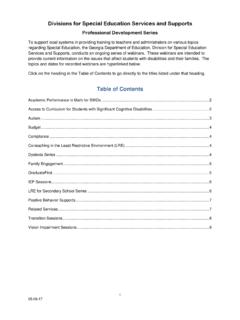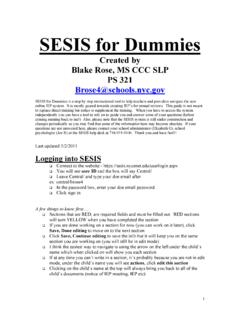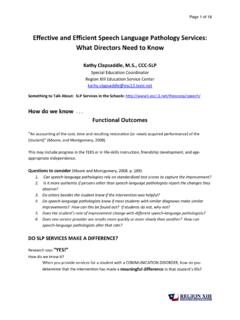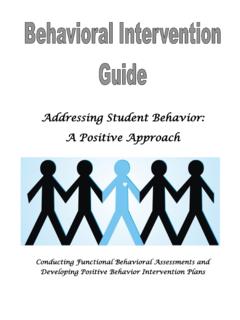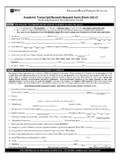Transcription of Progress Monitoring Challenges/Appropriate …
1 1 Progress Monitoring Challenges/Appropriate Responses Questions Answers 1) What are the potential positive results for Progress Monitoring for ELLs? ELLs face the dual challenge of learning a new language and learning in that new language. Therefore, a comprehensive approach to Progress Monitoring includes academic Progress Monitoring , as well as Monitoring the ELL s ongoing level of acculturation and new language development all within the context of comparisons to ELL s true peers . For a comprehensive list of evidence based Progress Monitoring tools, go to the National Center on response to Intervention at include a Progress Monitoring Tools Chart to assist educators and parents in becoming informed consumers of a variety of reading and mathematics Progress Monitoring tools that meet the needs of their students. When appropriately implemented, a comprehensive Progress Monitoring approach yields the following positive results: Gives teachers data about ELL s Progress and needs in meeting CSOs and English Language Proficiency Standards Helps teachers plan differentiated lessons based on individual needs Helps teachers vary instructional techniques based on individual needs Provides a common reference point for ESL teachers, classroom teachers, reading interventionists, etc.
2 2) What are the challenges and appropriate responses within the current RTI Progress Monitoring system for ELLs? Challenge: How can school districts establish procedures, including the selection of appropriate assessment tools, for schools to appropriately screen and Progress monitor English Language Learners? Example: Ms. Jones, an ESL educator, discovers that a Level 3 Beginning English Fluency student is being considered for Tier 3 services because the student has not made adequate Progress in Tier 2. This student, while quite fluent in Basic Interpersonal Communication, still has a limited vocabulary. Since this student belongs to a cultural group that places a strong emphasis on knowing the right answer, the student hesitates to read words with which she is unfamiliar. Recommended response : Procedures for screening and Progress Monitoring ELL s should be developed by an Intervention Team that draws upon the expertise of the English Second Language (ESL) educator responsible for the student s English language acquisition and development.
3 Challenge: How can the Intervention Team assure that screening and Progress Monitoring assessments are providing reliable and valid data for ELLs? Example: Mr. Smith, an RTI specialist, screens a newly enrolled ELL. The student is from an Asian country and has great difficulty articulating sounds that must be 2 echoed back to the assessor as a part of the screening. The student is assessed as needing intensive instruction in phonemic awareness, even though the student can read on grade level in his native language. Recommended response : Screening and Progress Monitoring assessment tools must be critically evaluated by the Intervention Team to assure that they provide reliable and valid data for ELLs. Cultural or linguistic assessment biases must be considered and eliminated. Some standard American English sounds may not found in the student s native language; similarly, letters used in standard American English words and in the student s native language may look the same but are pronounced differently.
4 Basic Cultural Awareness and Second Language Acquisition training should be provided to all assessors as well as a review of national and state guidelines that require ELL s be compared to true peers when assessing their performance Challenge: How can the team differentiate between language and/or academic delays and the influence of the student s own cultural characteristics? Example: Miss Black, an RTI interventionist, attempts to screen a newly enrolled ESL student. The student refuses to make eye contact with Miss Black and will not speak to her. Miss Black refers the student to the Autism Team. The student is from a culture where it is rude for children to make eye contact with adults. Recommended response : ELLs come from a variety of cultures, and their individual learning needs and language proficiencies differ widely. It is very common for ESL students to go through a silent period when first adjusting to their situation. Ensuring that school staff members are adequately trained to address these concerns is an important part of each school s professional development plan.
5 ESL teachers have expertise in second language acquisition characteristics such as silent period and often have experience with students from a variety of cultural norms. In addition, the team may choose to review research based literature regarding the specific cultural and linguistic characteristics for each ELL they are serving. Challenge: What other factors (emotional, behavioral, time in US, parent background) should be weighed when Monitoring the Progress of ELLs? Example: Mr. Martinez, an RTI specialist, has Progress monitored an ELL in Tier 3 for 100 sessions and his findings suggest that the student needs to be tested for special education. The student has not made the requisite gains in oral reading fluency and comprehension. The student has a history of limited formal schooling. The student s parents are not literate in either their native language or English. Recommended response : The most accurate way to measure ELL Progress is within a context that compares them to true peers.
6 If several true peers are struggling, this is 3 an indication that the instruction is less than optimal for that group of students. In some situations such as a small number of ESL students or great diversity in certain districts, it may be difficult to examine the achievement of the student s true peers . In these situations, it is important to ask the ESL teacher regarding his/her perspective of true peers , conduct additional research and determine if true peers exist within your community and district, or seek further technical assistance from state or national resources. 3) What are the challenges and recommended responses within the current RTI approach to Interventions for ELLs? Challenge: How can schools ensure appropriate scheduling of all required services and avoid the unintended consequence of pulling students out of general education instruction too much? Example: An ESL student is pulled from general education instruction for ESL services. In addition, he/she is pulled out for RTI and could potentially be removed again for other services (Title I, Speech etc.
7 The cumulative impact could mean the student misses a substantial amount of general education classroom instruction. Recommended response : All educators should work collaboratively through the LEP Committee to develop a schedule that best serves the needs of the student. Team members should try to coordinate services schedules with other specialists to be there on different days or offset time. If the general education teacher needs support in offering appropriate Tier 1 or Tier 2 interventions to the ELLs, another possibility is to have some services pushed in to the classroom with individual/academic instructional support. Challenge: How can schools ensure that the content and focus of all intervention services are coordinated and not operating in isolation? Example: When an ELL is removed from class for ESL services, the ESL teacher provides instruction on an area that is no aligned to or redundant of the focus of the interventionist instruction. Recommended response ESL services, as noted in the 2008 Memo ( ) are considered a Tier 2 intervention within the RTI Model.
8 Collaboration between the ESL teacher, the interventionists, and the classroom teacher is important in interpreting and addressing the needs based on the screening instrument. Supplementary/RTI materials should be made available to help the ESL teacher have the resources to ensure they are reinforcing the general educational curriculum as well. Similarly, the ESL teacher can help the classroom teacher and interventionist understand the instructional and cultural strategies that can be used to help with developing English proficiency within the classroom. Neither the RTI nor the ESL curriculum is more/less important than the other but both must be considered within the context of individual ELL needs. Collaborations (Title I, Special Education, Interventionists and ESL teachers) 4 Questions Answers 4) What role do ESL Services play as a Tiered Intervention? All ELLs should begin in TIER 1 instruction in the general education classroom with appropriate classroom modifications and accommodations.
9 The LEP committee is responsible for determining the nature and extent of ESL services for each student based on the results of their English proficiency screening and according to county guidelines. (Schools should refer to West Virginia Connections Toolkit for Connecting Classroom Best Practices and Limited English Proficient Students for appropriate identification and placement schedule). Tier 1 sometimes an ELL may have progressed in the development of his/her English proficiency so that he/she no longer requires direct ESL services but may not be ready to exit the ESL program. These students should be monitored by ESL teacher. In these instances, the ESL teacher may serve as a resource to the classroom teacher by providing information on: o The student s cultural and language background o Second language acquisition processes o appropriate instructional and assessment strategies Tier 2 By definition, an ELL has limited English proficiency and needs additional support to learn English.
10 For ELLs with negligible to intermediate proficiency levels, direct ESL services will be provided by an ESL teacher and these services are considered as a Tier 2 intervention Tier 3 When an ELL has demonstrated limited response to targeted intervention at Tier 2 and continues to have considerable and persistent academic difficulty, the problem solving team may recommend Tier 3. Tier 3 intervention is very explicit and intensive; may include the use of an alternative reading or mathematics program; is long term in nature; and, may necessitate a multidisciplinary evaluation for special education. Special Education Evaluation Referral for information regarding moving ELLs to Tier 3, refer to question #8. ESL services may support ELLs across all three tiers as well as within special education. Challenge: The ELL is having difficulty with Phonemic Awareness and Phonics. Example: A recently enrolled ESL student is limited in both their first and second language and lacks an understanding in both languages that words can be broken down into a series of sounds.
